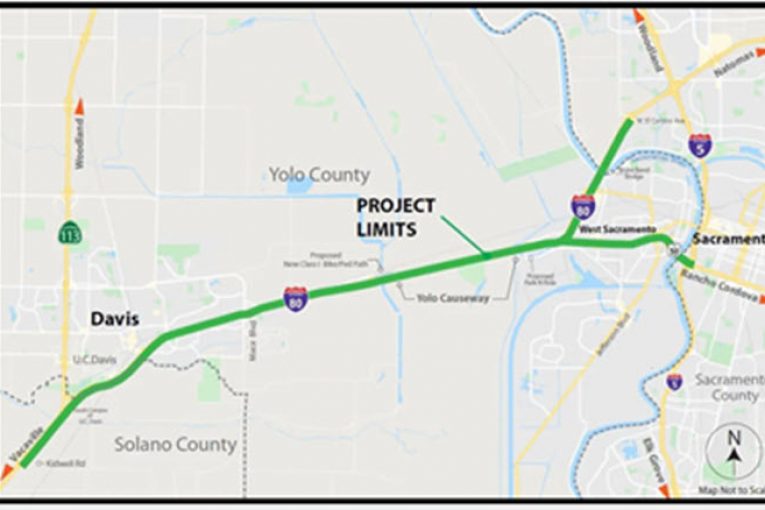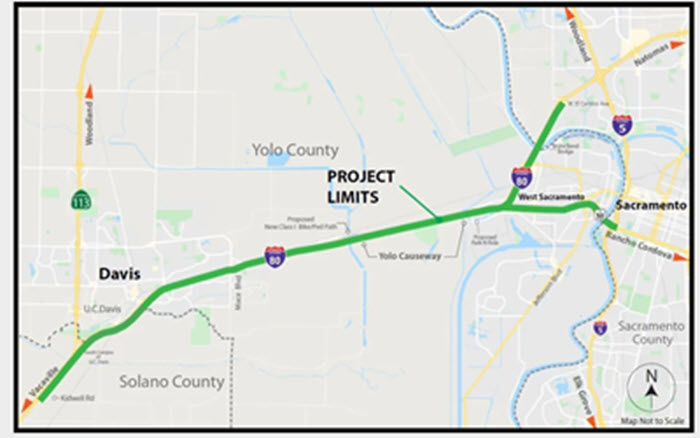

I-80 Elected Ignore UC Davis Studies
By Alan Hirsch
Will personal experience and intuition triumph over decades of research from universities across the county?
That is the issue surrounding how to deal with the peak hour traffic congestion on I-80. The issue has been brought to a head by the $86 million dollars in free money from Congress, a down payment on the $380 million project.
Breaking the board’s silence on the matter, Chair Tom Stallard of the Yolo Transportation District (YoloTD) spoke at the 7/17 meeting stating it was “for the record.” Up to this point the board has been silent during months of criticism from the public and UC Davis researchers stating that widening I-80 will not fix congestion for long but will move us in the wrong direction on climate change. The criticism based on extensive academics studies, including historical evidence that Caltrans traffic forecasts have consistently been inaccurate when they state a widening or HOV lanes will fix congestion. These Caltrans forecast ignore the phenomenon known as “induced demand. “
“
At the board meeting, Chair Stallard fell back on his intuition arguing that widening the freeway would fix congestion but failed to mention that the peak congestion was from recreational Tahoe travel. He spoke about his concerns for his family and their need to drive (assumably on the freeway) to swim and piano lessons for grandchildren.
Though he noted the board had received “letters,” he failed to mention their authors by name or rebut research from UC Davis and other transportation research centers on the “induced demand.” (YoloTD does not make such letters received by the board available in written record of the meetings.)
Supervisor Lucas Frerichs acknowledged that “While of views on adding a lane can differ…” following Stallard’ statements and then noted adding an HOV lane is destined to fail…yet he went on to only advocate tye new lane must be tolled. The authors of the public comment letters (Professors Susan Handy and Steve Wheeler) noted this will also fail.
No board members used the terms VMT, GHG or “induced demand” when discussing the widening of I-80. Instead, the concerns they expressed are about the loss of toll revenue if the $86 million is used and the phase I of project is completed on schedule but without the tolling facilities (Fastrack). Without tolling facilities, there will be no funds for any mitigation such as improved bus service.
This is a tough one for the electeds: they are torn between whether they listen to scientists or the project proponents at Caltrans.
Two Views on I-80: Decide for yourself
I present the two arguments on the I-80 widening below so you can make up your own mind.
First, a letter from Professor Susan Handy, head of the National Center for Sustainable Transportation and a Davis resident. Second, a letter from UC Davis Urban Studies Professor Stephen Wheeler’s letter asking for transit alternative in the EIR (see the Vanguard).
I then offer the “for the record” comment of YoloTD chair Tom Stallard in response to both Handy’s letter and Professor Wheeler’s letter.
Professor Handy: “Studies have conclusively established….
Dear Chair Tom Stallard and members, Yolo Transportation District Board of Directors.
I support CTC California Transportation Commission) staff recommendation to not fund the Yolo 80/US 50 Corridor Improvement Project at this time. I oppose this project based both on my expertise as one of the top transportation researchers in the country and as a long-time resident of Davis.
Academic studies have convincingly and conclusively established that increases in highway capacity led to increases in vehicle miles of travel (VMT). The work by my team at the Institute of Transportation Studies at the University of California, Davis shows that traditional methods for evaluating highway widening projects consistently underestimate the increase in VMT that such projects generate, thereby over-estimating their benefits with respect to congestion reduction and under-estimating their impacts with respect to greenhouse gas emissions and other environmental impacts. Increased emissions associated with the increase in VMT swamps any reduction in emissions stemming from what will inevitably be a temporary improvement in traffic flow. In short, highway widening projects are inconsistent with the state’s goal for reducing greenhouse gas emissions.
As a solution to congestion, highway widening projects are ineffective, as research as well as historical experience demonstrate. This is true whether the project is a conventional lane, or a managed lane open to private vehicles. The only proven way to reduce congestion is to combine congestion pricing with substantial investments in alternatives to driving, particularly high-quality transit service. Investments in transit as a mitigation for the highway widening rather than a replacement for it are also ineffective, in that the highway widening reduces the incentive to use transit. Any attempts to mitigate the increase in VMT short of implementing a pricing strategy is likely to fall short.
As a Davis resident I regularly observe traffic on I-80 when bicycling to south Davis and when driving to Sacramento at various times of day. Yes, traffic slows in Davis, but it rarely reaches extreme levels except on Friday afternoons. This level of congestion can only be considered a problem because we have set unrealistic standards for travel time and because we have given people few alternatives to driving. The solution is not to persist in a century-old approach that has proved unsuccessful time and time again. The solution is a new way of thinking about transportation.
Susan Handy
YoloTD Chair Stallard: “We just have to be realistic…
I read the letters sent to us this afternoon. Lot of ideas, good ideas. But I have grandchildren, so I really care about their future, and (unclear) environment these days, you’re not paying attention. (unclear)
But with respect for the issue of the 4th lane, I look at this in this context of an interstate freeway that basically goes from Mexico to Canada. From the Carquinez Bridge it is at least 4 lanes except from Sacramento to Davis, so it is not so much we are working so hard on this to create more vehicle mile traveled we are trying to eliminate what has become a terrible bottle neck.
That inconveniences thousands of people. I understand some people like the fact there is congestion as it forces them to seek other options, but I think of the fact of my daughter with two young children both of which who have swim team and work out, have piano lessons at different times, (for) all these things transit is not a viable option in many circumstances for many people.
I know the kind of expectations put on many of us in many places in our roles, but we just have to be realistic.
That said, I am a firm believer in the value of transit. (gestures to Lucas Frerichs ). You sat on (Capitol Corridor rail) joint powers board for many years, they have done a beautiful job. Traveling in the first-class comfort of the train. I feel like, I hope people don’t assume we don’t care about environmental implications. We are just the last in line Solano County has moved forward to more accommodating in context of I-80 as it exists over 70 or 80 miles. (stet: only 40). I don’t believe in revolution over evolution, The loss of tolling is horrendous. The Golden Gate Bridge toll pays for buses. I wanted to put this on the record. I really believe the district is on the right path.
Transcribed from YoloTD board meeting video time beginning stamp:1:06 https://youtu.be/O7odnLgxuF4

Is Stallard saying that I-80 runs from Mexico to Canada?